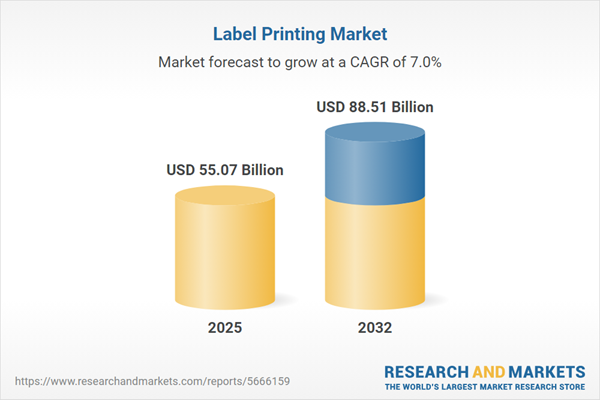Speak directly to the analyst to clarify any post sales queries you may have.
The global label printing market is undergoing rapid transformation as organizations encounter new regulatory demands, technological advancements, and mounting obligations around sustainability. Senior leaders who adopt future-oriented labeling strategies can better navigate compliance pressures, supply chain evolution, and the growing need for greater transparency.
Market Snapshot: Global Label Printing Market Size and Growth
In 2024, the global label printing market is valued at USD 51.46 billion, with expectations to rise to USD 55.07 billion by 2025 and reach USD 88.51 billion by 2032. Persistent growth stems from rising demands for advanced compliance oversight, the integration of next-generation supply chain technologies, and swift adoption of digital solutions. Companies that align labeling workflows with prevailing standards and improve traceability strengthen their efficiency and competitive positioning in diverse industries. Continuous advancement in supply chain management, technology-driven production processes, and evolving consumer preferences are propelling the global label printing market into new phases of operational excellence.
Scope & Segmentation
- Printing Technologies: Digital inkjet delivers customizable, just-in-time production for shifting business needs. Electrophotography ensures precision and adaptability for varied production scales. Flexography addresses large-scale, sector-specific manufacturing requirements, with an emphasis on consistent productivity. Thermal, laser, and thermal transfer technologies provide robust, compliant solutions suitable for demanding operational settings.
- Material Types: Film-based substrates (polyester, polyethylene, polypropylene) meet durability standards and perform in challenging applications. Metal materials are chosen for intensive asset tracking and products needing long-lasting labels. Paper-based substrates offer cost-effectiveness for quick-turnover environments where long-term durability is secondary.
- End Use Industries: Electronics and manufacturing employ labeling for accurate inventory tracking and process documentation. Healthcare relies on specialized labels to ensure stock accuracy and regulatory compliance. Food and beverage companies use labeling for safety, shelf-life control, and supply chain transparency. Retail, logistics, and transportation integrate labeling solutions to support process efficiency and facilitate operational visibility.
- Applications: Key uses include fulfilling regulatory requirements, optimizing logistics, clarifying inventories, and increasing brand recognition. Automation and smart label adoption reduce manual oversight and enable consistent, scalable operations in dynamic markets.
- Regions: The Americas, Europe, Asia-Pacific, the Middle East, and Africa each present unique growth drivers based on region-specific technology integration and market regulation. Organizations with multinational operations benefit by adapting scalable and collaborative approaches to address diverse regulatory landscapes.
- Notable Companies: Industry leaders such as Avery Dennison Corporation, CCL Industries Inc., Multi-Color Corporation, Constantia Flexibles, WestRock Company, Toppan Printing, All4Labels Group, Skanem AS, Schreiner Group, and Herma GmbH are driving innovation in labeling technologies and sustainability.
Key Takeaways for Senior Decision-Makers
- Investing in digital infrastructure allows timely adaptation to shifting regulatory landscapes and elevated customer expectations in the global label printing market.
- Transitioning to recyclable and compostable label materials sends a clear signal of sustainable practice and builds confidence among stakeholders and partners.
- Harnessing process automation and intelligent labeling improves traceability, minimizes errors, and ensures robust compliance across all operational stages.
- Organizational consolidation opens new pathways for scaling operations and sustaining consistent quality standards even as industry complexity rises.
- Supplier diversification strategies boost resilience, equipping organizations to tackle sudden disruptions or market shifts efficiently and reliably.
- Formulating proactive risk management accounts for diverse local regulations, technology transitions, and sector-specific compliance needs in a globally dynamic environment.
Tariff Impact: Strategic Adjustments to U.S. Policy Changes
Recent modifications to U.S. tariffs on labeling materials have led many enterprises to reassess sourcing models and procurement policies. In response, companies are adopting nearshoring tactics, renegotiating supplier terms, and deploying flexible systems for agility. Advances in laminate technologies further empower organizations to adapt quickly to evolving policy and commercial changes while preserving supply chain responsiveness.
Methodology & Data Sources
This analysis is supported by in-depth interviews with senior executives and technical experts at leading labeling companies. Multi-stage validation involved cross-referencing reports from industry bodies, regulatory documentation, and independent research to maintain accuracy and objectivity.
Why This Report Matters
- Delivers actionable insights into technology shifts and regulations to inform strategic business and compliance decisions.
- Equips organizations to identify operational barriers, improve risk management, and strengthen planning for future industry shifts.
- Directly supports strategy development for regulatory adaptation and sustainability across all major labeling sectors.
Conclusion
Ongoing advancements and targeted supply chain measures are setting the tone for the global label printing market. Organizations prioritizing agility and continuous innovation are positioned to effectively manage regulatory changes and operational demands.
Additional Product Information:
- Purchase of this report includes 1 year online access with quarterly updates.
- This report can be updated on request. Please contact our Customer Experience team using the Ask a Question widget on our website.
Table of Contents
3. Executive Summary
4. Market Overview
7. Cumulative Impact of Artificial Intelligence 2025
Companies Mentioned
The companies profiled in this Label Printing market report include:- Avery Dennison Corporation
- CCL Industries Inc.
- Multi-Color Corporation
- Constantia Flexibles Group GmbH
- WestRock Company
- Toppan Printing Co., Ltd.
- All4Labels Group GmbH
- Skanem AS
- Schreiner Group GmbH & Co. KG
- Herma GmbH
Table Information
| Report Attribute | Details |
|---|---|
| No. of Pages | 193 |
| Published | November 2025 |
| Forecast Period | 2025 - 2032 |
| Estimated Market Value ( USD | $ 55.07 Billion |
| Forecasted Market Value ( USD | $ 88.51 Billion |
| Compound Annual Growth Rate | 7.0% |
| Regions Covered | Global |
| No. of Companies Mentioned | 11 |









